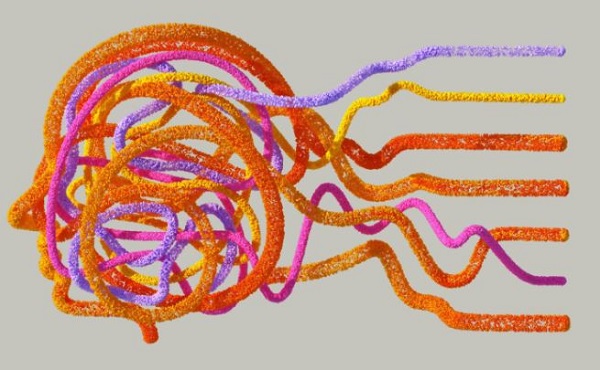
Image courtesy of Pexels
As new trends and platforms reshape the NFT space, NFT collectors are no longer limited to a single trading platform.
Although OpenSea is a major player in the NFT marketplace space, there are alternative platforms that offer more functionality, advanced analytics, lower transaction fees, and many more unique features tailored to suit different collectors.
Read on to explore the top five OpenSea alternatives for NFT collectors worth checking out in 2025.
Magic Eden is a leading cross-chain NFT marketplace for discovering, buying, minting, selling, and trading non-fungible tokens. The platform also supports the trading of fungible tokens.
Originally launched on the Solana blockchain, the platform has since expanded to support other networks, including Bitcoin, Ethereum, BNB Chain, Arbitrum, ApeChain, Polygon, and more, making it a go-to marketplace for multi-chain NFT minting and trading.
Although OpenSea is a major player in the NFT marketplace space, there are alternative platforms that offer more functionality, advanced analytics, lower transaction fees, and many more unique features tailored to suit different collectors.
Read on to explore the top five OpenSea alternatives for NFT collectors worth checking out in 2025.
Magic Eden
Magic Eden is a leading cross-chain NFT marketplace for discovering, buying, minting, selling, and trading non-fungible tokens. The platform also supports the trading of fungible tokens.
Originally launched on the Solana blockchain, the platform has since expanded to support other networks, including Bitcoin, Ethereum, BNB Chain, Arbitrum, ApeChain, Polygon, and more, making it a go-to marketplace for multi-chain NFT minting and trading.
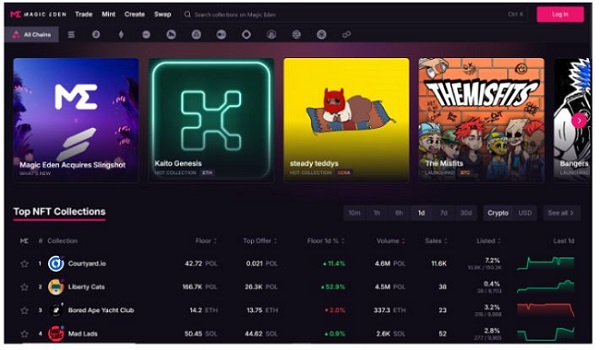
Key Info
Launch year: 2021
Location: San Francisco, California
Focus: Creators, brands, and avid collectors
Native token: $ME
Features
● Clean, beginner-friendly UI: It has a clutter-free and intuitive interface that makes browsing and trading NFTs seamless.
● Low fees: The platform charges a 2% fee on transactions, which is cheaper than that of other platforms.
● Mint Terminal: Collectors can explore and discover real-time NFT drops across multiple platforms, making it easy to spot NFT mints early.
● Wide selection of NFTs: Magic Eden features a diverse range of NFT collections, making it perfect for NFT collectors.
● Creator Hub: Collectors who want to create and launch their NFTs have access to a wide range of tools for listing and managing their NFT collections.
● $ME token: The $ME token is designed to support community engagement and may be used in future governance initiatives.
Pros & Cons
Pros
Cons
Rarible is another popular NFT marketplace that allows users to create, buy, and sell NFTs without coding skills.
The platform takes a community-driven approach, allowing holders of its native token, $RARI, to participate in governance and decision-making. In the long term, Rarible plans to evolve into a fully decentralized autonomous organization (DAO).
Launch year: 2021
Location: San Francisco, California
Focus: Creators, brands, and avid collectors
Native token: $ME
Features
● Clean, beginner-friendly UI: It has a clutter-free and intuitive interface that makes browsing and trading NFTs seamless.
● Low fees: The platform charges a 2% fee on transactions, which is cheaper than that of other platforms.
● Mint Terminal: Collectors can explore and discover real-time NFT drops across multiple platforms, making it easy to spot NFT mints early.
● Wide selection of NFTs: Magic Eden features a diverse range of NFT collections, making it perfect for NFT collectors.
● Creator Hub: Collectors who want to create and launch their NFTs have access to a wide range of tools for listing and managing their NFT collections.
● $ME token: The $ME token is designed to support community engagement and may be used in future governance initiatives.
Pros & Cons
Pros
- Beginner-friendly platform
- High liquidity
- Multi-chain support
- User-centric interface
- Advanced analytics
Cons
- Limited functionality on the mobile app
Rarible
Rarible is another popular NFT marketplace that allows users to create, buy, and sell NFTs without coding skills.
The platform takes a community-driven approach, allowing holders of its native token, $RARI, to participate in governance and decision-making. In the long term, Rarible plans to evolve into a fully decentralized autonomous organization (DAO).
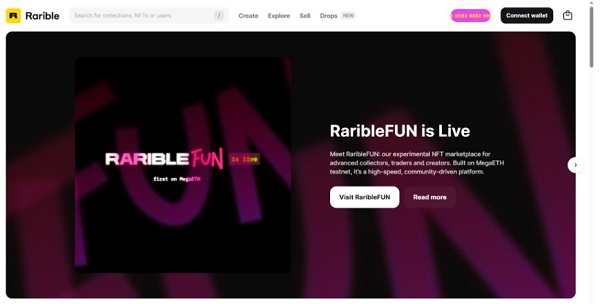
Key Info
Launch year: 2020
Location: Wilmington, Delaware
Focus: Creators and collectors
Native token: $RARI
Features
Pros & Cons
Pros
Cons
Designed specifically for professional NFT traders, Blur supports the buying, selling, and trading of Ethereum NFTs. The Ethereum-based NFT marketplace offers zero trading fees, allowing users to trade without incurring transaction costs.
Besides its native token, BLUR, the platform also offers a myriad of tools that allow NFT collectors to have a seamless experience on the platform.
Launch year: 2020
Location: Wilmington, Delaware
Focus: Creators and collectors
Native token: $RARI
Features
- Aggregated marketplace: Rarible aggregates NFT listings from various blockchains, enabling collectors to explore NFTs on different networks.
- Bulk buying: The platform allows collectors to purchase multiple NFTs in a single transaction, saving on gas fees.
- RARI token: Collectors can vote on key platform decisions using the RARI token.
Pros & Cons
Pros
- Large selection of NFTs
- Native governance token
- Supports credit card payments
Cons
- Faces stiff competition from well-established platforms
Blur
Designed specifically for professional NFT traders, Blur supports the buying, selling, and trading of Ethereum NFTs. The Ethereum-based NFT marketplace offers zero trading fees, allowing users to trade without incurring transaction costs.
Besides its native token, BLUR, the platform also offers a myriad of tools that allow NFT collectors to have a seamless experience on the platform.
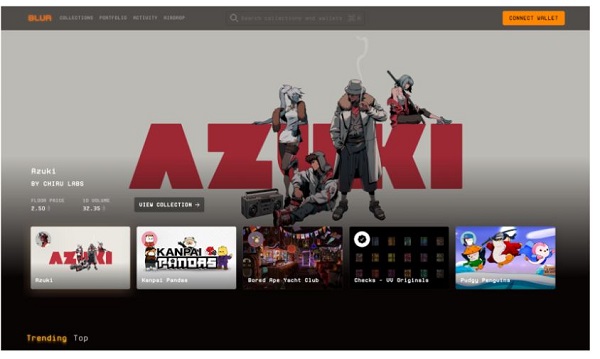
Key Info
Launch year: 2022
Location: San Francisco, California
Focus: Professional NFT traders
Native token: $BLUR
Features
Pros & Cons
Pros
Cons
SuperRare is a curated NFT marketplace based on the Ethereum network. As an art-focused platform, SuperRare offers high-quality, unique digital art as it prioritizes exclusivity and quality. The platform allows users to discover and collect unique digital artwork.*
As an exclusive platform, SuperRare requires artists to apply and get approval before creating NFTs on the platform. Its native token, RARE, is used for governance and to admit new artists to the SuperRare spaces.
Launch year: 2022
Location: San Francisco, California
Focus: Professional NFT traders
Native token: $BLUR
Features
- Batch sweeping: Collectors can purchase multiple NFTs at once from a single collection, saving on gas fees and time.
- Real-time data analytics: The platform’s real-time price feeds provide NFT collectors with up-to-date information to make informed buying decisions.
- Zero trading fees: Using Blur, collectors can save money as the platform charges zero marketplace fees.
Pros & Cons
Pros
- Designed for professional traders
- Uses aggregated listings
- Zero transaction fees on trade
Cons
- Lacks multi-chain support
- Not suitable for novice collectors
SuperRare
SuperRare is a curated NFT marketplace based on the Ethereum network. As an art-focused platform, SuperRare offers high-quality, unique digital art as it prioritizes exclusivity and quality. The platform allows users to discover and collect unique digital artwork.*
As an exclusive platform, SuperRare requires artists to apply and get approval before creating NFTs on the platform. Its native token, RARE, is used for governance and to admit new artists to the SuperRare spaces.
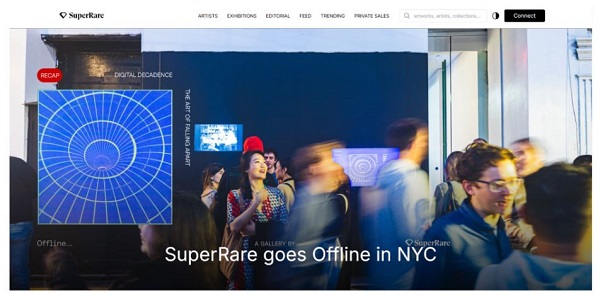
Key Info
Launch year: 2018
Location: San Diego, California
Focus: High-quality creators and high-net-worth collectors
Native token: $RARE
Features
Pros & Cons
Pros
Cons
Similar to SuperRare, Foundation is an exclusive, art-focused NFT marketplace that’s built on the Ethereum blockchain. The platform allows digital creators to create, curate, and showcase their NFT projects.
Unlike open NFT marketplaces, Foundation operates as an invite-only marketplace, where existing artists invite new artists, guaranteeing high-quality, exclusive artworks.
Additionally, the platform allows creators to sell their collections in eight different ways, which adds flexibility and makes it more appealing to NFT collectors.
Launch year: 2018
Location: San Diego, California
Focus: High-quality creators and high-net-worth collectors
Native token: $RARE
Features
- Art focus: The platform is ideal for NFT collectors who are keen on high-quality, unique NFT artworks.
- Exclusive art experience: As a curated platform, SuperRare has a sleek design that makes it desirable for collectors who want an aesthetically pleasing platform.
- High-quality NFTs: Its exclusive nature guarantees collectors high-quality NFTs as it’s not an open platform.
Pros & Cons
Pros
- Diverse digital art assets
- It’s an exclusive marketplace featuring high-quality NFTs
- Suitable for high-net-worth collectors
Cons
- High fees
- Limited to digital art only
Foundation
Similar to SuperRare, Foundation is an exclusive, art-focused NFT marketplace that’s built on the Ethereum blockchain. The platform allows digital creators to create, curate, and showcase their NFT projects.
Unlike open NFT marketplaces, Foundation operates as an invite-only marketplace, where existing artists invite new artists, guaranteeing high-quality, exclusive artworks.
Additionally, the platform allows creators to sell their collections in eight different ways, which adds flexibility and makes it more appealing to NFT collectors.
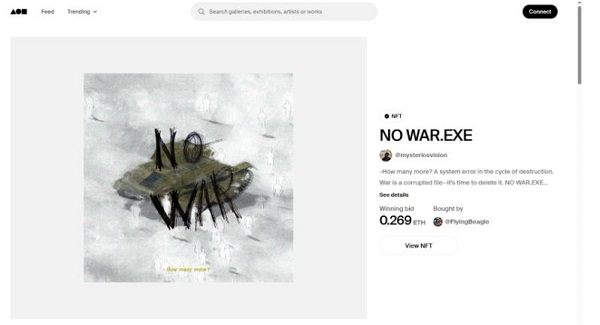
Key Info
Launch year: 2021
Location: San Francisco, California
Focus: Digital artists and collectors
Native token: None
Features
Pros & Cons
Pros
Cons
Choosing a suitable marketplace all boils down to your personal needs and preferences.
For instance, Magic Eden is a great community-centric, cross-chain NFT marketplace tailored to both creators and collectors looking for a long list of features. On the other hand, Foundation and SuperRare are suitable for collectors looking for an exclusive marketplace for NFT artworks.
While Rarible is great for collectors who want to have a say in how a platform is governed, Blur is ideal for collectors who rely on real-time data analytics for decision-making.
Whatever your collecting style, our list of OpenSea alternatives above will most definitely help you choose a platform that’s a suitable fit for you.
Launch year: 2021
Location: San Francisco, California
Focus: Digital artists and collectors
Native token: None
Features
- Drops: Collectors can directly mint a creator’s NFT art collection thanks to the drop feature.
- Gallery-like UI: Foundation has a minimalist and clean user interface that’s easy to navigate.
- Reserve auction: Gives collectors a fair chance to bid and buy top NFT pieces at a minimum price.
Pros & Cons
Pros
- Art-focused NFT collections
- High-quality curated NFTs
- User-friendly interface
Cons
- The platform accepts ETH only
Which OpenSea alternative is a Suitable Fit For You?
Choosing a suitable marketplace all boils down to your personal needs and preferences.
For instance, Magic Eden is a great community-centric, cross-chain NFT marketplace tailored to both creators and collectors looking for a long list of features. On the other hand, Foundation and SuperRare are suitable for collectors looking for an exclusive marketplace for NFT artworks.
While Rarible is great for collectors who want to have a say in how a platform is governed, Blur is ideal for collectors who rely on real-time data analytics for decision-making.
Whatever your collecting style, our list of OpenSea alternatives above will most definitely help you choose a platform that’s a suitable fit for you.
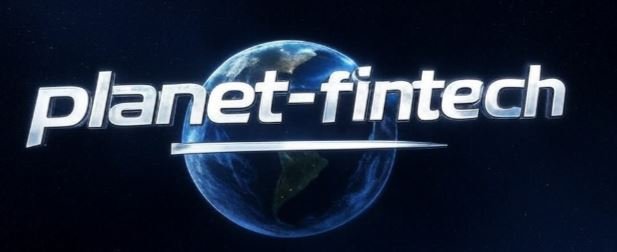
 Actus AssurTech / InsurTech
Actus AssurTech / InsurTech







